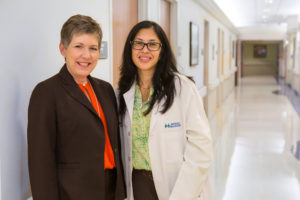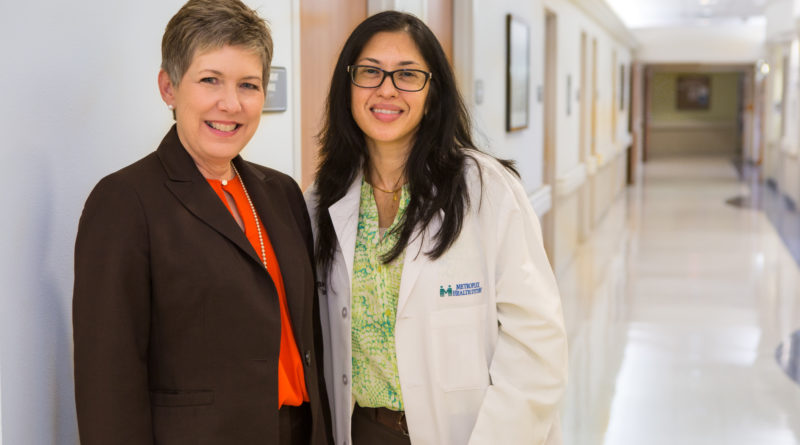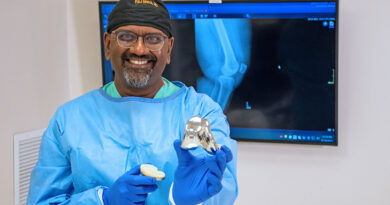A new kind of patient experience at Metroplex
Story by Catherine Hosman | Photos by Mike Bartoszek
Times are changing for the patient/doctor relationship.
Thanks to new technology patients can access their medical records and recent lab and procedure results through a hospital’s patient portal. With the click of a button, patients now have access to major medical research on the world wide web. This gives people the ability to study their own illness, compare the doctor’s recommendations, learn about medications prescribed and work with their doctor(s) to come up with the best care program to ensure the best outcome for their diagnosis. More and more doctors are listening to their patients needs and encouraging patients to become their own advocates.

Robin Bodkin, executive director of marketing and patient experience for Metroplex Health System said defining the patient experience was a group effort of Adventist Health System. “It’s treating a person as if they were the one you loved the most,” she said.
“Patient experience begins the moment a person walks into their doctor’s office, have a procedure, and all the touch points along the way,” she said.
A patient admitted to the hospital already has a lot on his or her mind, she said. They are dealing with anxiety, they are not feeling well, they may not be mentally aware of their situation or they may be having family issues.
“It’s important that a nurse and doctor can communicate with a patient,” Bodkin said.
Elements of patient experience begin with the nurse or doctor listening to a patient’s needs and questions. Bodkin said medical professionals must be receptive to patients.
“It’s been proven that many doctors interrupt between the first 12 and 18 seconds when meeting with a patient,” Bodkin said. “If you have a story to tell, it may be interrupted.”
Secondly, the doctor, or nurse, should answer any patient questions and explain clearly to address those needs. “Patients should not be afraid to ask questions and get to the heart of what the matter is and what is important to them,” she said. “When a physician listens to you, he or she connects with you and everybody wins.”
And thirdly, every interaction between medical professionals and patients should be done with courtesy and respect.
“When a patient leaves the hospital they will receive a survey,” said Bodkin, adding that surveys help the medical staff learn about things that are not working well, or that are working very well.
A new way to communicate
Slowly the old ways of a singular doctor diagnosing and treating a patient, with no input from the patient, is giving way to a new type of doctor/patient communication.
“Historically, patients wanted physicians to be authoritarians. It’s been that way for years. Now we are a service industry. (Patient communication) was not taught. Now it’s being taught in medical schools,” said Bindu Raju, M.D., hospitalist.
Raju added that the authoritarian physician is a thing of the past.
“Now doctors and patients are partners. We’re not just looking at our patient to make a decision. We make the decision as a group,” she said.
Raju said what Bodkin is trying to achieve in patient experience is primarily for doctors who graduated 10 years ago or more.
“All physicians want to be good, be the best for the patient, the way they experience their lives,” Raju said. “We need to take what is on the inside to the outside and let them shine.”
“We are working to get barriers out of the way,” added Bodkin.
To help physicians learn about patient experience, Bodkin implemented the Physician Communications Skills Lab. Both she and Raju facilitate the classes.
“It teaches the skills of communication,” she said. “It’s a simple thing. Doctors should listen to the patient. If you are a patient having surgery, ask any question. It’s best for the patients and doctors and provides the best outcome.”
Another proven skill for the new doctors is teaching them that sitting down with a patient immediately says “I have time for you.”
“When a doctor sits, the perception is he or she has stayed longer,” Bodkin said. “This makes it obvious they want to hear what you have to say. Our hospitalists give out business cards to their patients so they can call if they have a question.”
But not all patients are easy to get along with despite the new training for doctors.
“We learn how to de-escalate an aggressive patient. If you don’t have the presence of mind it can blow up right away,” Raju said. “By sitting, you de-escalate the situation once a patient realizes you care about them. They will calm down and not be disrespectful.”
At the end of the day, Bodkin said their mission is to extend the healing ministry of Christ, “Are we hitting that mark? Ask the patient if we are hitting the mark.
“What higher aspiration is there then to help people and get them what they need?” Bodkin continued. “On any given day I know I’ve helped one person. Maybe I prayed with them, gave them a hug — we touch people’s lives all day long. I’m the one who gets blessed by it. When I do something for a patient, they want to thank me — I want to thank them.”




